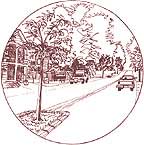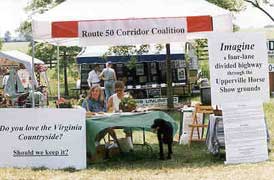 |
| ||||||||||||||||||||||||||||||||
The Coalition’s original grass roots group has been joined by hundreds of citizens and other organizations throughout the region and elsewhere. The Coalition is guided by an active steering committee that represents a broad spectrum of the community. Funds to carry out its work have come from individual contributions, large and small, and from several foundations. Continued financial support is vital to sustain the organization’s efforts. The Issues In 1994, the Virginia Department of Transportation (VDOT) rekindled an idea to build Route 50 bypasses around Aldie and Middleburg. This would lead to expanding Route 50 from a two-lane road to a multi-lane divided highway from Lenah to just east of Paris, a distance of about 20 miles, with an additional bypass around Upperville. Local citizens and business owners grew profoundly concerned regarding the prospective effects of this proposed construction on local commerce, the environment, and the scenic and historic integrity of the area. Residents were appalled by the specter of a 200-foot wide right-of-way for a high-speed highway (probably to be designated a truck route) being carved out of the beautiful, largely unspoiled Virginia Piedmont countryside. The Citizens Respond In response, local and regional citizens’ organizations formed the Route 50 Corridor Coalition in 1995 to seek alternatives to VDOT’s high-speed, multi-lane highway with bypasses. The Coalition did its own research, raised private funds, and hired Ian Lockwood, an internationally known and respected transportation engineer who suggested that traffic calming would be an ideal solution. Emergence of a Traffic Calming Plan Mr. Lockwood assisted the Coalition and the community in conducting a series of educational and hands-on design workshops attended by about 700 people. The principal concerns from a transportation perspective were identified as excessive speed of motor vehicle traffic, aggressive driving, poor and unsafe conditions for pedestrians, harm to historic buildings, and noise from high-speed traffic, particularly trucks. The intensive effort at the workshops resulted in the development of an innovative traffic calming plan for the 20-mile section of rural Route 50. The plan and the process by which it was developed are documented in a two-volume report, “A Traffic Calming Plan for Virginia’s Rural Route 50 Corridor, Fauquier and Loudoun Counties, Including Aldie, Middleburg, and Upperville” published by the Coalition in 1996.
Recognition and Support In addition to support from local, regional, state and federal entities, the Coalition has received requests for information from planners, engineers, citizens’ groups, and state departments of transportation located in more than 40 states. National organizations have endorsed the plan, and major articles and stories have appeared in journals, magazines, and newspapers, including the New York Times and the Washington Post. The project has been presented at national, regional and local conferences. The Institute of Transportation Engineers granted Ian Lockwood and the Route 50 Traffic Calming Plan its prestigious 1997 Past Presidents Award. The Coalition’s Goals As part of the process of producing the traffic calming plan, the citizens defined a vision of the Route 50 corridor as: “a scenic, unique, rural community in an historical, agricultural, quiet, and natural setting.” This vision statement was developed as a means to guide and assess land use planning and transportation decisions for the corridor. The Route 50 Corridor Coalition’s goal is to participate in community initiatives to further this vision Important issues other than traffic calming will continue to require attention. The Loudoun County Revised Comprehensive Plan, the proposed Western Bypass, and potential developments at Gilbert’s Corner are major concerns at present. So, although progress on the traffic calming project is cause for optimism, the Coalition’s work is by no means over. |
In Memoriam | ||||||
 | ||||||
About the Coalition | What is Traffic Calming? Rt. 50 Traffic Calming Plans |The Corridor’s History|News| | ||||||
 The Coalition was started in 1995 to find an alternative to plans for expanding 20 miles of Route 50 to a four-lane divided highway with bypasses around the villages of Aldie, Middleburg, and Upperville.
The Coalition was started in 1995 to find an alternative to plans for expanding 20 miles of Route 50 to a four-lane divided highway with bypasses around the villages of Aldie, Middleburg, and Upperville. The Route 50 Corridor Coalition is a citizens group formed to preserve and enhance the scenic, historic countryside bounding a 20-mile stretch of rural Route 50 in northern Virginia’s Piedmont.
The Route 50 Corridor Coalition is a citizens group formed to preserve and enhance the scenic, historic countryside bounding a 20-mile stretch of rural Route 50 in northern Virginia’s Piedmont. The many public meetings could not have been held without the generous help of local entities that made facilities available – particularly the Middleburg Community Center, Emmanuel Episcopal Church, Middleburg Methodist Church, the American Legion Hall, Hill School, Aldie Methodist Church, Upperville Baptist Church, Middleburg Elementary School and Oatlands.
The many public meetings could not have been held without the generous help of local entities that made facilities available – particularly the Middleburg Community Center, Emmanuel Episcopal Church, Middleburg Methodist Church, the American Legion Hall, Hill School, Aldie Methodist Church, Upperville Baptist Church, Middleburg Elementary School and Oatlands.